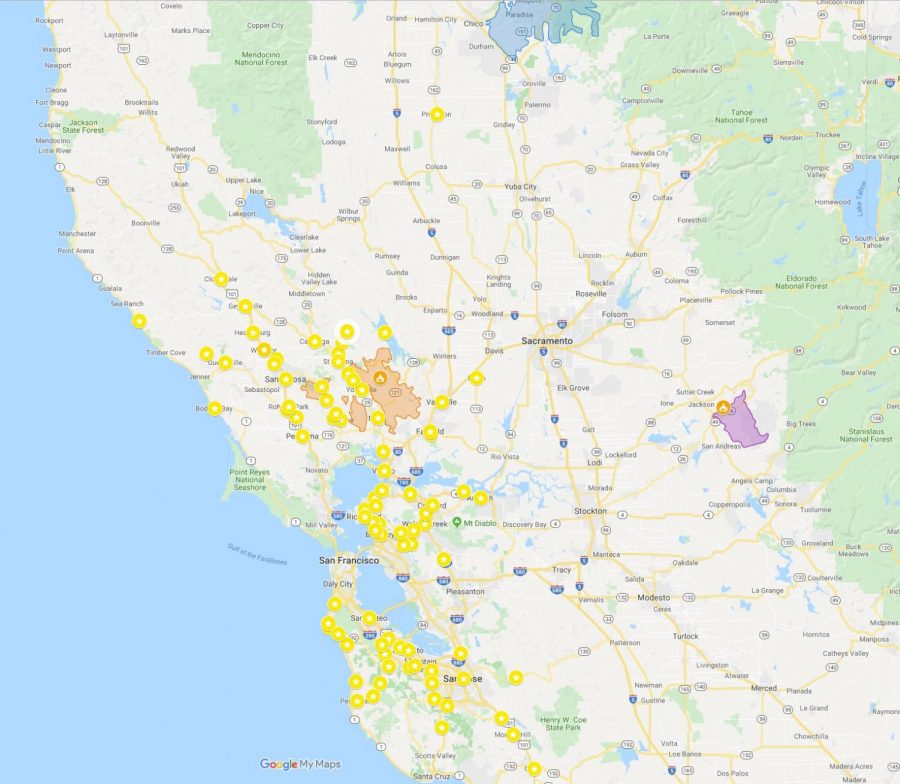Trying to Learn from the Past: PG&E Shuts off Power to 800,000 Californians in Attempt to Prevent Fires
In this map, the yellow dots represent cities affected by the power outage. The blue shaded area represents the Camp Fire in 2018, the purple shaded area represents the Sacramento Fire in 2015, and the orange shaded area represents the Napa fires in 2017. Map Illustration: Sophia Artandi using Google Maps.
October 18, 2019
From Wednesday, Oct. 9 to Saturday, Oct. 12, Pacific Gas & Electric (PG&E) cut power to 800,000 Californians in an unorthodox attempt to prevent wildfires, enraging customers in affected areas. According to the PG&E website, the decision to shut off power is a part of the utility giant’s new commitment to public safety in the wake of their shaky track record regarding California fires.
PG&E admitted that their equipment was responsible for the 2018 Camp Fire in Paradise, which ultimately killed 85 people. In addition, trees hitting PG&E power lines resulted in a 2015 fire that covered over 700,000 acres and the Napa fires of 2017, which burned more than 100,000 acres, the New York Times said.
California’s infamously dry climate inevitably leads to fires, especially from June to September. On top of that, powerful winds cause fires to spread three times faster, according to the Los Angeles Times. The second fire season, from October to April, is driven by the Santa Ana winds, which bring strong gusts from the Great Basin to Southern California.
While California’s dry climate allows for wildfires to start and spread quickly, PG&E’s equipment has started them. Preceding the 2018 Camp Fire, PG&E admitted that some of their structures were at risk of collapse but let them remain anyway. One of these unstable structures, Tower 27/222, started the Camp Fire, which burned more than 150,000 acres. According to The New York Times, PG&E could have obtained approval from state regulators to replace it before the fire happened.
Now PG&E must address the problem in court. In January, they filed for Chapter 11 bankruptcy protection due to their estimated $30 billion in wildfire liabilities, and the company has recently lost exclusive control for proposing a reorganization plan in court. Under bankruptcy law, the company should initially have exclusive power to create a reorganization plan. However, in this situation, Judge Dennis Montali ruled that bondholders are allowed to pitch a plan as well.
The utility argued that granting bondholders the ability to develop a plan was premature because they have not gotten an accurate number on how much the liabilities will be. In addition, the bondholders will try to get a large stake in the company and take control.
However, according to The New York Times, the bondholders are offering upwards of $14.5 billion to the victims, whereas PG&E is only offering $8.4 billion. The bondholders’ plan gives them a 59% stake and allocates $29.2 billion into the company. Furthermore, 41 percent of the stock would be relocated to trusts to help pay the damages brought to light by the wildfire victims.
Cutting power to 34 out of the 58 counties in California was a precaution against sparking more fires and in turn causing more problems in court. These planned outages, called Public Safety Power Shutoffs (PSPS) will be used in the future as well, according to the PG&E website. “We want all of our customers to be prepared for [the] possibility [of more PSPS,] no matter where they live or work,” the website said.



